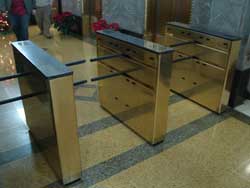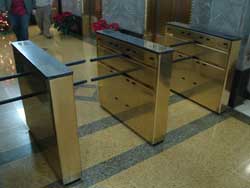
Homeland Security Insider
Turning a New Page
 FOUR years in the making, the drive to implement HSPD-12 at long
last began by issuing smart identification cards last October. Every
federal agency has now opened at least one facility where employees can
go to get personal identification verification (PIV) cards fitted to
the strict criteria of FIPS 201. This year, federal agencies will begin
to activate a massive interoperable system of card readers in which any
agency's readers will be able to read and process cards presented by
any and all federal employees -- no matter what agency employs them.
FOUR years in the making, the drive to implement HSPD-12 at long
last began by issuing smart identification cards last October. Every
federal agency has now opened at least one facility where employees can
go to get personal identification verification (PIV) cards fitted to
the strict criteria of FIPS 201. This year, federal agencies will begin
to activate a massive interoperable system of card readers in which any
agency's readers will be able to read and process cards presented by
any and all federal employees -- no matter what agency employs them.
In the next year, HSPD-12 implementation will revolutionize
government security by beginning to install an interoperable access
control system that officials from any government agency can trust.
Before receiving the card, the employee must show identification and
have his or her photograph and fingerprints verified to prove the
person picking up the card is the person who applied for it.
The Department of Defense developed and implemented its own smart card system several years ago. In fact, DOD's system reportedly served, to some extent, as a model for the government-wide access control system now being assembled.
When the employee presents this card to the readers that will begin
to appear at federal doorways, a technological verification system will
answer up to three questions. The number of questions depends upon the
security required at the door being accessed. The three questions are:
- Is the card authentic?
- Is the card presented really that of the person presenting it?
- Does the card remain in good standing in the database?
Establishing and starting up a card-issuing system that can be
trusted across the entire federal government has been the goal for PIV
cards. During the next several months, the goal is interoperability --
upgrading or replacing access control readers, intelligent boards and
servers so that the federal government's physical access control system
will be able to read, evaluate, respond to and trust the new cards.
GSA is already testing and accrediting readers, ensuring the
technology can read the data on the cards. Approved readers appear on
the GSA's Information Technology Schedule 70 under Special Item No.
132-62. GSA has not written standards for access control systems.
Instead, the agency has decided to leave the details up to the access
control vendors.
Some departments of the federal government have developed access
control systems that will meet the requirements of HSPD-12 without too
much trouble. The Department of Defense developed and implemented its
own smart card system several years ago. In fact, DOD's system
reportedly served, to some extent, as a model for the government-wide
access control system now being assembled.
At the other extreme, some agencies have never done much more than
have a security guard monitor people as they walk through the doors.
These agencies are starting from scratch. As these systems come on line
with readers and updated access control devices to communicate with new
cards, around 5 million federal employees and members of the armed
services will begin to discover that their credentials are trusted by
readers, access control systems and people across the entire federal
government.
Smart cards are only part of the access control solution. Readers
and other access control devices to augment the work done by security
guards are necessary to perfect a complete solution. One technology
gaining popularity is the optical turnstile. Optical turnstiles are
often an integral part of a modern sophisticated access control system.
Typically, optical turnstiles are integrated into a building's lobby
architecture to provide a medium level of security at the main entry
point while complementing the building's aesthetic features. Accepted
alike by security/facility managers and architect/designers, the
concept of optical turnstiles seems to be a reliable blend of security
and design considerations.
Essentially, an optical turnstile works by detecting passage of a
body between two pedestals (or bollards) by the use of infrared optical
beams. Typically, a system of lights and sounders are integrated as the
user interface and the system is controlled by the turnstile
manufacturer's firmware. The optical turnstile also houses card readers
and communicates with the customer's HSPD-12-compliant access control
system.
In a typical transaction, the optical turnstile reads a card from
the user, communicates with the access control system to verify
authorization and admits one body to pass through in the correct
direction. Tailgaters, piggybackers and other unauthorized people are
singled out by visible and audible alarms, as well as by creating a
recordable event in the client's access control system that typically
must be addressed by on-duty staff.
However, these products provide a low-to-medium level of security.
Though the technology aids lobby staff in screening entries to the
building, it does not replace the need for lobby staff. A common
scenario is to have one lobby staff person screen visitors, handle
inquiries and monitor the traffic at the turnstile.
An optical turnstile system does not take the place of security
personnel at the entry point, as a security portal or mantrap would.
Optical turnstiles generally do not physically prevent unauthorized
entry as a mechanical turnstile can. However, due to fast throughput
and high aesthetic value, optical turnstiles are commonplace in today's
corporate and government lobbies. By most accounts, barrier-type
optical turnstiles have accounted for more than 75 percent of all
optical turnstile sales in the past six years. This fact can be partly
attributed to the greater concern for and acceptance of lobby security
since Sept. 11, 2001.
The greater demand also is a result of the fact that the technology
in this product range has improved greatly in recent years. Improved
throughput, more reliable motor drive systems for the barriers, greater
safety from accidental closing of the barriers and improved emergency
egress capabilities are some of the recent advances.
One product that has come to the forefront of the market in recent
months is the Delta 7000-B by Delta Turnstile Controls. Delta is an
American-made swinging barrier arm product with features like a small
footprint, fast throughput, low false alarm occurrence, warranty and
optional crawl-over detection.
What's next for government access control? How about onboard asset
tracking technology, integration with on-the-go biometrics readers,
bomb/weapons detection systems? As long as security managers need to
know who is entering or leaving the building and what that person is
bringing with them, the possibilities are endless. Stay tuned.
This article originally appeared in the February 2007 issue of Security Products pg. 48.